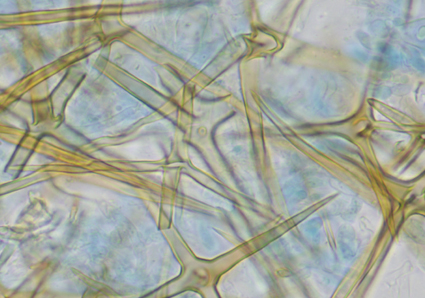Abstract
A new corticioid fungus from Guizhou Province in southwest China, Asterostroma rhizomorpharum, is described and illustrated based on morphological and molecular evidence. It is characterized by producing annual, resupinate basidiomata with long rhizomorphs, a dimitic hyphal structure with simple septa on generative hyphae, asterosetae frequently present in subiculum, asterohyphidia present in hymenium, ellipsoid to subglobose, and echinulate and amyloid basidiospores (5.5–6.8 × 4.6–5.9 μm). The phylogenetic analysis based on ITS+nLSU rDNA sequences shows that the new species belongs to the section Asterostroma.
References
- Anonymous. (1969) Flora of British fungi. Colour identification chart. Her Majesty’s Stationery Office: London, UK.
- Bernicchia, A. & Gorjón, S.P. (2010) Fungi Europaei 12. Corticiaceae s.l. Edizioni Candusso, Alassio. 1008 pp.
- Boidin, J., Lanquetin, P. & Gilles, G. (1997) Contribution à la connaissance du genre Asterostroma Massee 1889 (Basidiomycotina). Bulletin de la Société Mycologique de France 113: 269–301.
- Bresadola, G. (1920) Selecta mycologica. Annales Mycologici 18 (1–3): 26–70.
- Dong, J.H., Zhang, X.C. Chen, J.J., Zhu, Z.L. & Zhao, C.L. (2023) A phylogenetic and taxonomic study on Steccherinum (Polyporales, Basidiomycota): focusing on three new Steccherinum species from southern China. Frontiers in Cellular and Infection Microbiology 12: 1103579. https://doi.org/10.3389/fcimb.2022.1103579
- Duan, Z.Y., Guan, Q.X., Luo, K.Y. & Zhao, C.L. (2023) Morphological and molecular identification of three new resupinate species of Hyphoderma (Hyphodermataceae, Agaricomycetes) from East Asia. Phytotaxa 599: 1–19. https://doi.org/10.11646/phytotaxa.599.1.1
- Gafforov, Y., Ordynets, A., Langer, E., Yarasheva, M., Gugliotta, A., Schigel, D., Pecoraro, L., Zhou, Y., Cai, L. & Zhou, L.W. (2020) Species diversity with comprehensive annotations of wood-inhabiting poroid and corticioid fungi in Uzbekistan. Frontiers in Microbiology 11: 598321. https://doi.org/10.3389/fmicb.2020.598321
- Hall, T.A. (1999) Bioedit: a user-friendly biological sequence alignment editor and analysis program for windows 95/98/NT. Nucleic Acids Symposium Series 41: 95–98.
- Hallenberg, N. & Eriksson, J. (1985) The Lachnocladiaceae and Coniophoraceae of North Europoe. Fungiflora, Oslo, 96 pp.
- He, X., Dong, J.H. & Zhao, C.L. (2023) Morphological and molecular identification of a new species, Trullella yunnanensis (Steccherinaceae, Polyporales) from southern China. Kew Bulletin 78: 213–221. https://doi.org/10.1007/s12225-023-10081-4
- Kalyaanamoorthy, S., Min, B., Wong, T., von Haeseler, A. & Jermiin, L. (2017) ModelFinder: fast model selection for accurate phylogenetic estimates. Nature Methods 14: 587–589. https://doi.org/10.1038/nmeth.4285
- Krah, F.S., Seibold, S., Brandl, R., Baldrian, P., Müller, J. & Bässler, C. (2018) Independent effects of host and environment on the diversity of wood-inhabiting fungi. Journal of Ecology 106: 1–15. https://doi.org/10.1111/1365-2745.12939
- Larsson, K.H. (2007) Re-thinking the classification of corticioid fungi. Mycological Research 111: 1040–1063. https://doi.org/10.1016/j.mycres.2007.08.001
- Larsson, E. & Larsson, K.H. (2003) Phylogenetic relationships of russuloid basidiomycetes with emphasis on aphyllophoralean taxa. Mycologia 95: 1037–1065. https://doi.org/10.2307/3761912
- Liu, S.L., Tian, Y., Nie, T., Thawthong, A., Hyde, K., Xu, L.L. & He, S.H. (2017) Updates on East Asian Asterostroma (Russulales, Basidiomycota): new species and new records from Thailand and China. Mycological Progress 16: 667–676. https://doi.org/10.1007/s11557-017-1301-5
- Liu, Z.B., Wu, Y.D., Zhao, H., Lian, Y.P., Wang, Y.R., Wang, C.G., Mao, W.L. & Yuan, Y. (2022) Outline, divergence times, and phylogenetic analyses of Trechisporales (Agaricomycetes, Basidiomycota). Frontiers in Microbiology 13: 818358. https://doi.org/10.3389/fmicb.2022.818358
- Maddison, W.P. & Maddison, D.R. (2021) Mesquite: a modular system for evolutionary analysis, version 3.70. [http://www.mesquiteproject.org]
- Miller, S.L., Larsson, E., Larsson, K.H., Verbeken, A. & Nuytinck, J. (2006) Perspectives in the new Russulales. Mycologia 98: 960–970. https://doi.org/10.3852/mycologia.98.6.960
- Parmasto, E. (1971) The Lachnocladiaceae of the Soviet Union. With a key to the boreal species. Institute of zoology and botany, Academy of sciences of the Estonian S.S.R, Tartu, 167 pp.
- Patouillard, N.T. & Lagerheim, G. de. (1893) Champignons de l‘Equateur (Pugillus III). Bulletin de la Société Mycologique de France 9: 124–165.
- Petersen, J.H. (1996) Farvekort. The Danish Mycological Society´s Colour-Chart. Foreningen til Svampekundskabens Fremme: Greve, 1–6 pp.
- Ronquist, F. & Huelsenbeck, J.P. (2003) MrBayes 3: Bayesian phylogenetic inference under mixed models. Bioinformatics 19: 1572–1574. https://doi.org/10.1093/bioinformatics/btg180
- Suhara, H., Maekawa, N., Ushijima, S., Kinjo, K. & Hoshi, Y. (2010) Asterostroma species (Basidiomycota) from mangrove forests in Japan. Mycoscience 51: 75–80. https://doi.org/10.1007/S10267-009-0006-2
- Torrend, C. (1913) Les Basidiomycetes des environs de Lisbonne et de la région de S. Fiel (Beira Baixa). Brotéria Série Botânica 11: 54–98.
- Wang, H., Gu, Z.R. & Zhao, C.L. (2021) Hyphodermella zixishanensis (Polyporales, Basidiomycota), a new species with reddish hymenial surface. Nordic Journal of Botany 39: 1–7. https://doi.org/10.1111/njb.03329
- Yang, Y., Li, R., Liu, C.M. & Zhao, C.L. (2023) Morphological and molecular identification for two new species of wood-inhabiting macrofungi (Basidiomycota) from Yunnan-Guizhou Plateau, China. Phytotaxa 591: 1–18. https://doi.org/10.11646/phytotaxa.591.1.1
- Yuan, Q., Luo, K.Y., Zhang, Y. & Zhao, C.L. (2023) Morphological characteristics and phylogenetic analyses revealed three new wood-inhabiting fungi (Agaricomycetes, Basidiomycota) in southern China. Phytotaxa 592: 179–195. https://doi.org/10.11646/phytotaxa.592.3.1
- Zhao, C.L., Cui, B.K., Song, J. & Dai, Y.C. (2015) Fragiliporiaceae, a new family of Polyporales (Basidiomycota). Fungal Diversity 70: 115–126. https://doi.org/10.1007/s13225-014-0299-0
- Zhao, C.L., Qu, M.H., Huang, R.X. & Karunarathna, S. (2023) Multi-gene phylogeny and taxonomy of the wood-rotting fungal genus Phlebia sensu lato (Polyporales, Basidiomycota). Journal of Fungi 9: 320. https://doi.org/10.3390/jof9030320
- Zou, L., Zhang, X.L., Deng, Y.L. & Zhao, C.L. (2022) Four new wood-inhabiting fungal species of Peniophoraceae (Russulales, Basidiomycota) from the Yunnan-Guizhou Plateau, China. Journal of Fungi 8: 1227. https://doi.org/10.3390/jof8111227


